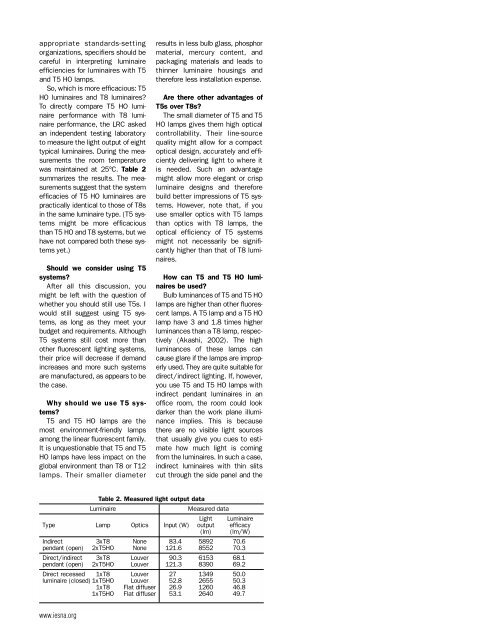From Pokemon to Tiffany's to LEED to DALI - Illuminating ...
From Pokemon to Tiffany's to LEED to DALI - Illuminating ...
From Pokemon to Tiffany's to LEED to DALI - Illuminating ...
You also want an ePaper? Increase the reach of your titles
YUMPU automatically turns print PDFs into web optimized ePapers that Google loves.
appropriate standards-setting<br />
organizations, specifiers should be<br />
careful in interpreting luminaire<br />
efficiencies for luminaires with T5<br />
and T5 HO lamps.<br />
So, which is more efficacious: T5<br />
HO luminaires and T8 luminaires<br />
To directly compare T5 HO luminaire<br />
performance with T8 luminaire<br />
performance, the LRC asked<br />
an independent testing labora<strong>to</strong>ry<br />
<strong>to</strong> measure the light output of eight<br />
typical luminaires. During the measurements<br />
the room temperature<br />
was maintained at 25°C. Table 2<br />
summarizes the results. The measurements<br />
suggest that the system<br />
efficacies of T5 HO luminaires are<br />
practically identical <strong>to</strong> those of T8s<br />
in the same luminaire type. (T5 systems<br />
might be more efficacious<br />
than T5 HO and T8 systems, but we<br />
have not compared both these systems<br />
yet.)<br />
Should we consider using T5<br />
systems<br />
After all this discussion, you<br />
might be left with the question of<br />
whether you should still use T5s. I<br />
would still suggest using T5 systems,<br />
as long as they meet your<br />
budget and requirements. Although<br />
T5 systems still cost more than<br />
other fluorescent lighting systems,<br />
their price will decrease if demand<br />
increases and more such systems<br />
are manufactured, as appears <strong>to</strong> be<br />
the case.<br />
Why should we use T5 systems<br />
T5 and T5 HO lamps are the<br />
most environment-friendly lamps<br />
among the linear fluorescent family.<br />
It is unquestionable that T5 and T5<br />
HO lamps have less impact on the<br />
global environment than T8 or T12<br />
lamps. Their smaller diameter<br />
results in less bulb glass, phosphor<br />
material, mercury content, and<br />
packaging materials and leads <strong>to</strong><br />
thinner luminaire housings and<br />
therefore less installation expense.<br />
Are there other advantages of<br />
T5s over T8s<br />
The small diameter of T5 and T5<br />
HO lamps gives them high optical<br />
controllability. Their line-source<br />
quality might allow for a compact<br />
optical design, accurately and efficiently<br />
delivering light <strong>to</strong> where it<br />
is needed. Such an advantage<br />
might allow more elegant or crisp<br />
luminaire designs and therefore<br />
build better impressions of T5 systems.<br />
However, note that, if you<br />
use smaller optics with T5 lamps<br />
than optics with T8 lamps, the<br />
optical efficiency of T5 systems<br />
might not necessarily be significantly<br />
higher than that of T8 luminaires.<br />
How can T5 and T5 HO luminaires<br />
be used<br />
Bulb luminances of T5 and T5 HO<br />
lamps are higher than other fluorescent<br />
lamps. A T5 lamp and a T5 HO<br />
lamp have 3 and 1.8 times higher<br />
luminances than a T8 lamp, respectively<br />
(Akashi, 2002). The high<br />
luminances of these lamps can<br />
cause glare if the lamps are improperly<br />
used. They are quite suitable for<br />
direct/indirect lighting. If, however,<br />
you use T5 and T5 HO lamps with<br />
indirect pendant luminaires in an<br />
office room, the room could look<br />
darker than the work plane illuminance<br />
implies. This is because<br />
there are no visible light sources<br />
that usually give you cues <strong>to</strong> estimate<br />
how much light is coming<br />
from the luminaires. In such a case,<br />
indirect luminaires with thin slits<br />
cut through the side panel and the<br />
Table 2. Measured light output data<br />
Luminaire<br />
Measured data<br />
Light Luminaire<br />
Type Lamp Optics Input (W) output efficacy<br />
(lm) (lm/W)<br />
Indirect 3xT8 None 83.4 5892 70.6<br />
pendant (open) 2xT5HO None 121.6 8552 70.3<br />
Direct/indirect 3xT8 Louver 90.3 6153 68.1<br />
pendant (open) 2xT5HO Louver 121.3 8390 69.2<br />
Direct recessed 1xT8 Louver 27 1349 50.0<br />
luminaire (closed) 1xT5HO Louver 52.8 2655 50.3<br />
1xT8 Flat diffuser 26.9 1260 46.8<br />
1xT5HO Flat diffuser 53.1 2640 49.7<br />
www.iesna.org

















